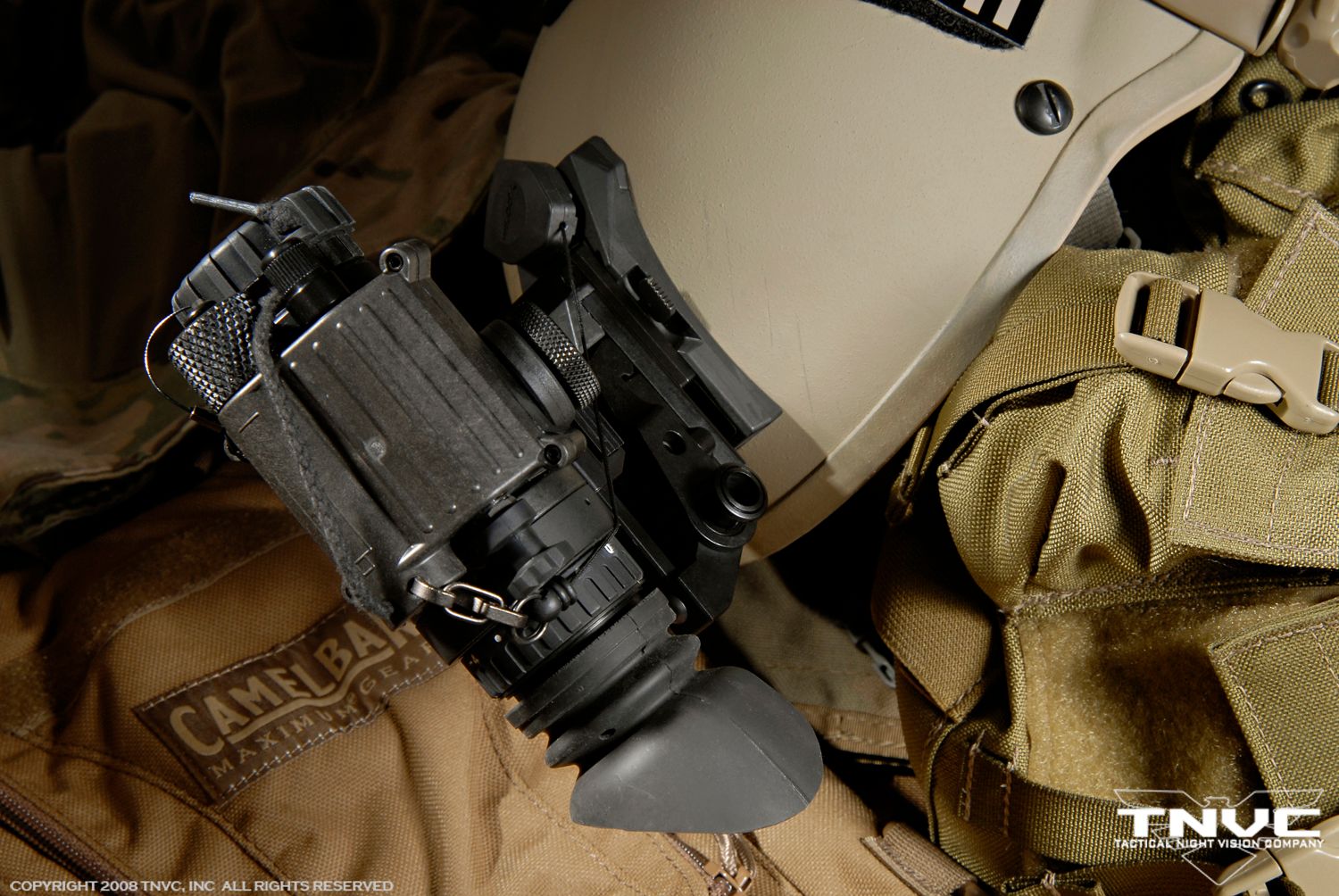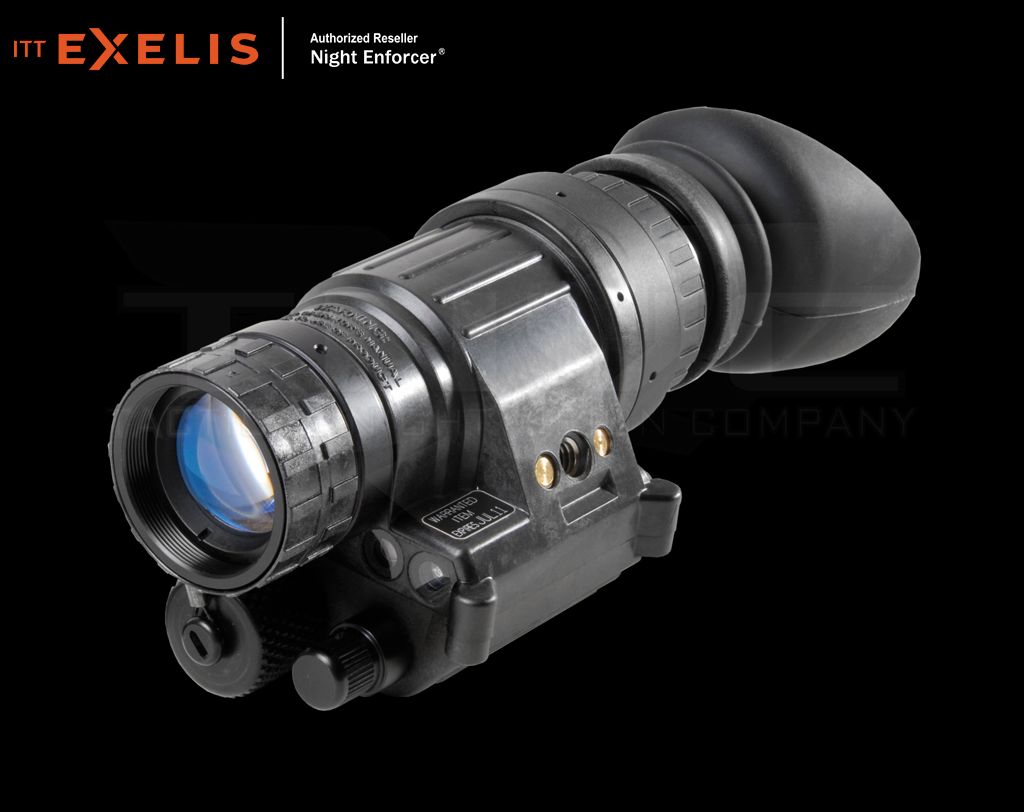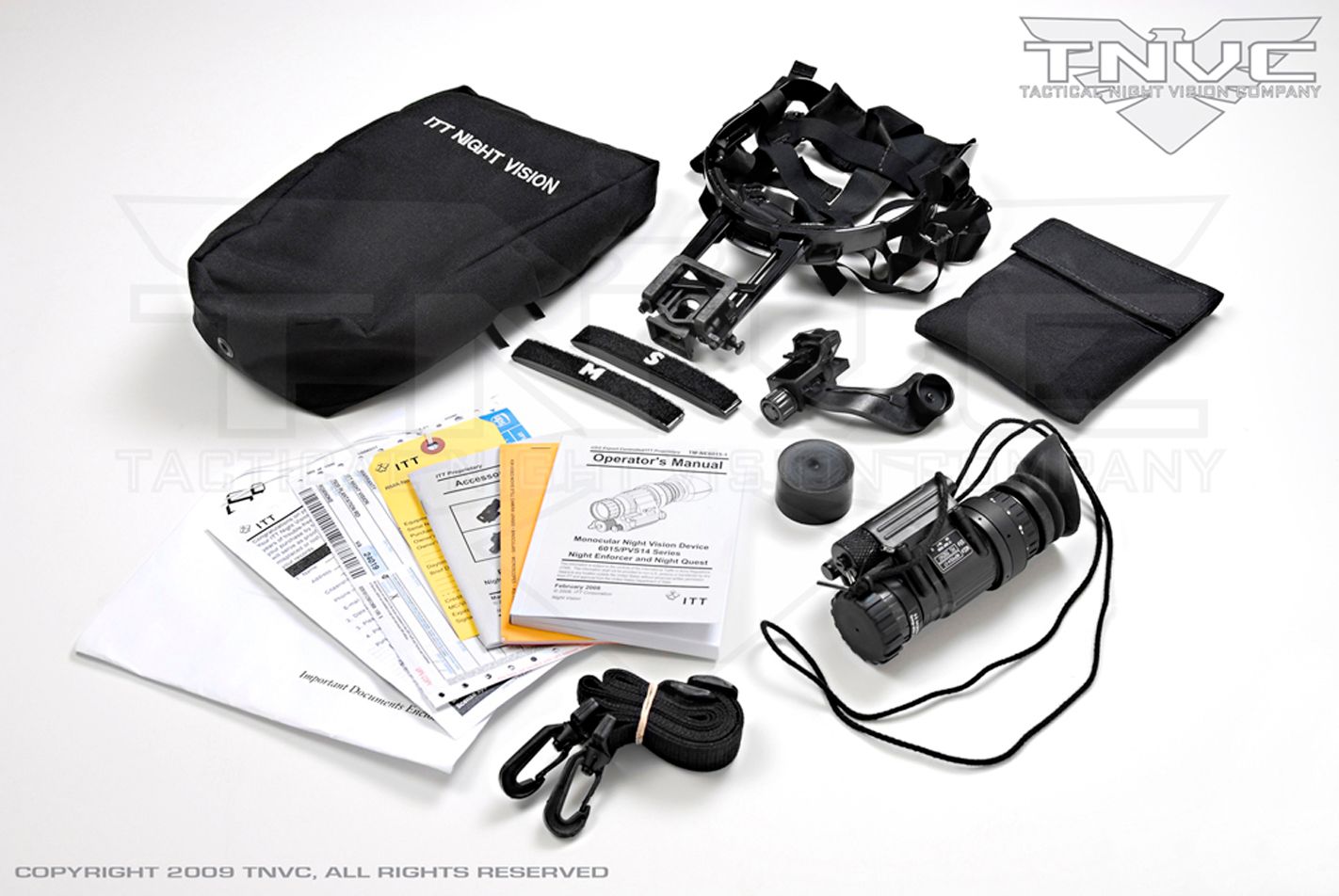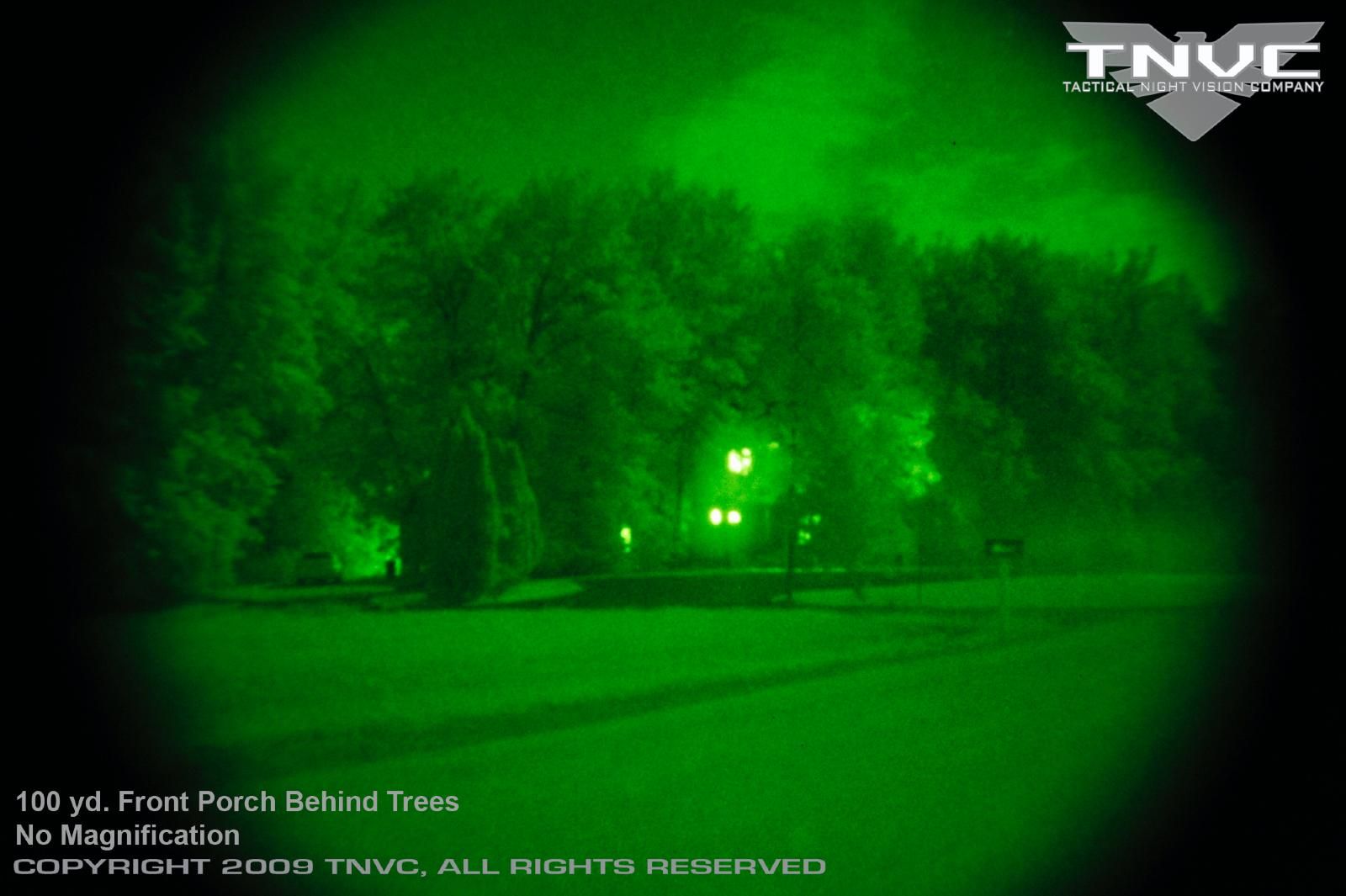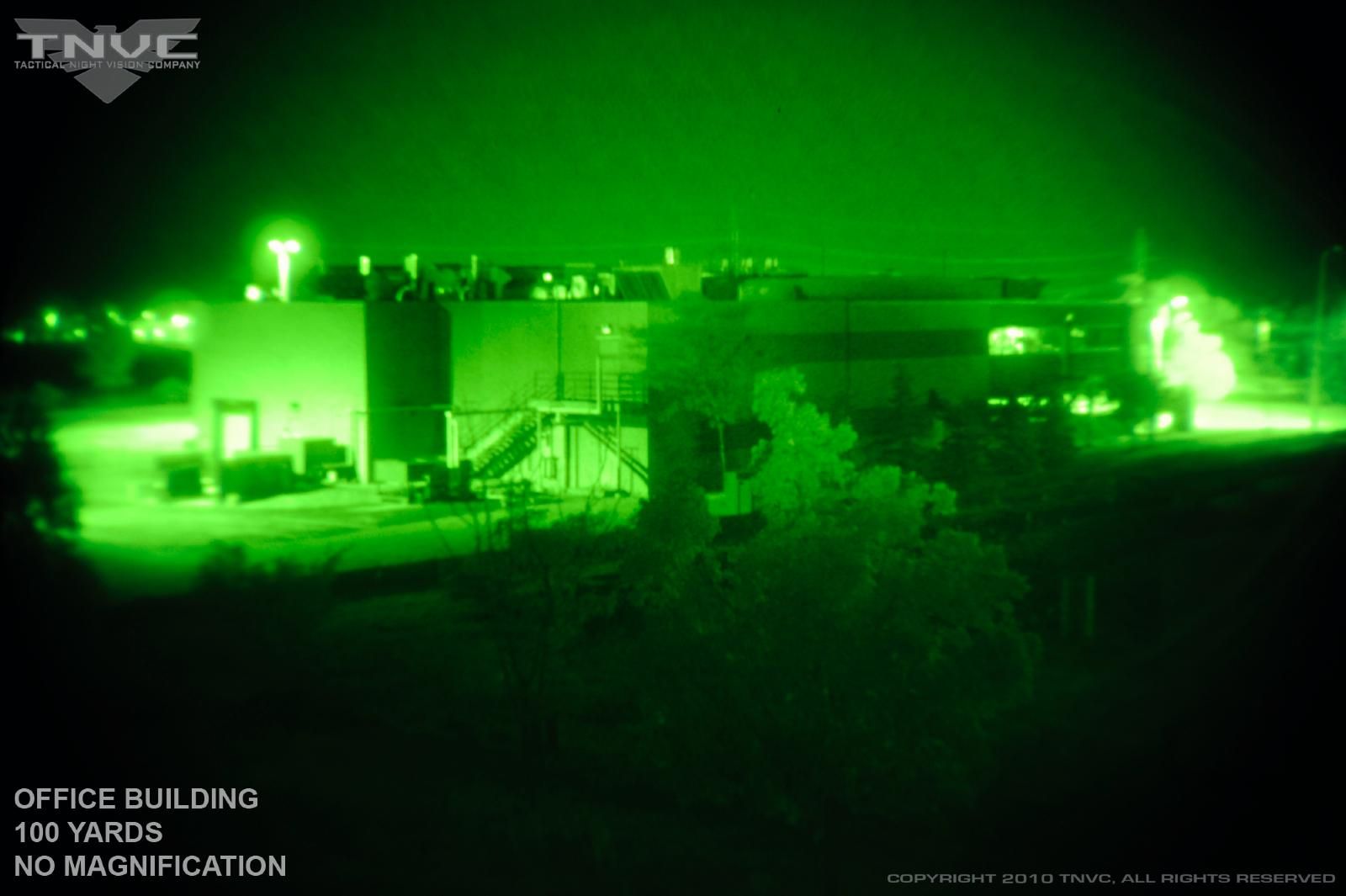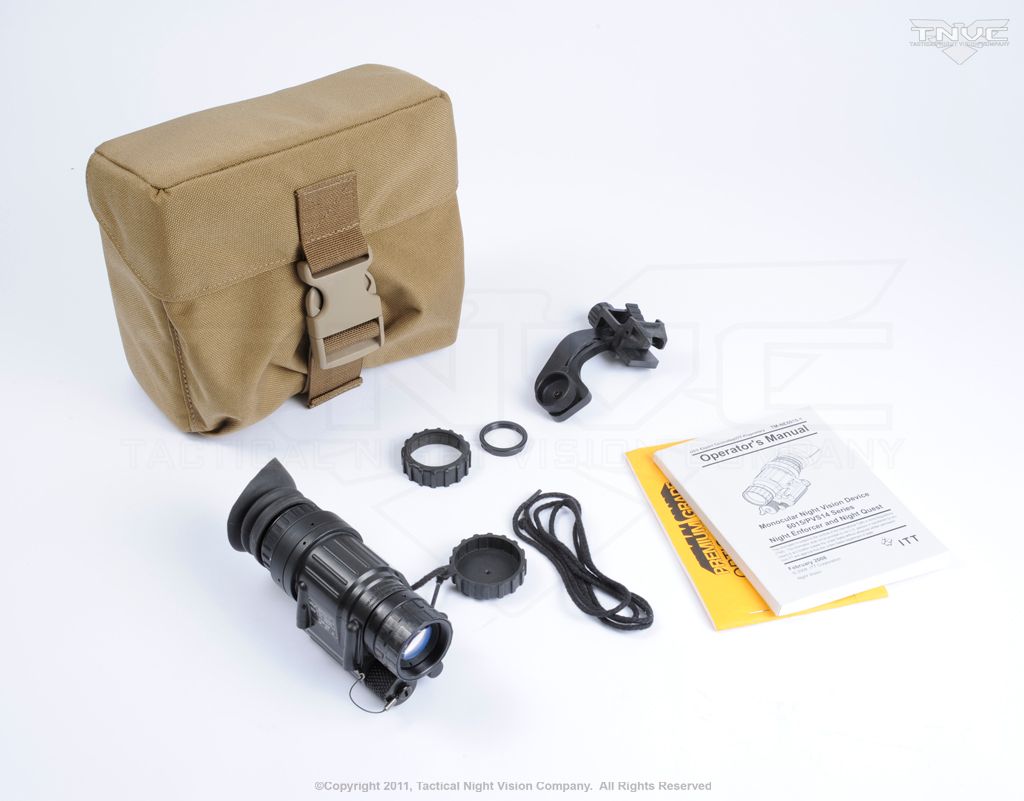One of the most commonly-asked questions we get at TNVC is: "What are the differences between the PVS-14's on your website?" This is a good question because it can be somewhat confusing. So, let's take a look at these devices and clear up the confusion. I'll start off with a bit of generic info. "PVS-14" is a military designation for a type of night vision monocular housing with a Generation 3 Image Intensifier Tube. PVS-14's use COTS (Commercial Off The Shelf) AA batteries, have manual Objective Focus and Diopter adjustment, and a built in IR Illuminator. All current-production PVS-14's have manual Gain Control and are powered by a single battery. This last part is important because some unscrupulous cottage industry night vision sellers will use older commercial ITT PVS-14 Night Quest housings and call them "brand new." While they may very well be brand new / never issued, they are by no means, new production.
**Off on a Tangent 1**
ITT used to manufacture several lines of PVS-14's for different markets. The original PVS-14 used a dual battery configuration, but this was quickly changed to a single battery setup because of weight complaints from the field. ITT's commercially-available PVS-14 was called the "Night Quest." These used dual battery housings and had an "NQ" prefix to the PVS-14 designation on the label. The Night Quest PVS-14 had an "ABC" circuit (Automatic Brightness Control) that would sense the amount of light coming in and would automatically adjust the brightness (gain) of the image. ITT's Law Enforcement line was called the "Night Enforcer," and featured the same single battery setup as the military issue system. Night Enforcers have an "NE" prefix on the label. Night Enforcers have a manually adjustable gain control knob located on the front of the unit, next to the on/off knob. The Military system uses the same housing as the Night Enforcer. Outwardly, the only difference is the label, which will say AN/PVS-14 (AN stands for Army/Navy), and has an NSN (National Stock Number).
ITT eventually developed PINNACLE©. In a nutshell, PINNACLE© is a proprietary thin film technology, only available from ITT Technologies that represents an enhancement to Generation 3 image intensifier technology. To understand PINNACLE© it is important to understand film technology in Gen3 tubes and why it is needed. Light energy, or “photons” strike the photocathode (the first surface in a Gen3 tube) causing electrons to be emitted out the other side, towards the Microchannel Plate (MCP). When they strike, they knock even more electrons out of other atoms, causing them to be positively charged (positive ions). The electrons pass through the MCP, continually multiplying and get converted back into photons for your eye to see as they pass through the phosphor screen. But, the positive ions created at the MCP travel in the opposite direction of the electrons and head back to the photocathode, striking it with significant force which can lead to damage. Suffice to say, Gen3 tubes are more sensitive to this damage than Gen2 and require a protective film barrier of Aluminum Oxide to get the life needed out of the tube. The Aluminum Oxide film is placed over the MCP to absorb the positive electrons before they can travel back to the photocathode to damage it. However, this film only allows about 50% of the electrons through, reducing the sensitivity, and represents the standard Gen3 tube. The government requested Gen4, the goal which, was to remove the film to allow 100% transfer. However, this severely cut the tube life and was deemed unacceptable. So, ITT produced a tube with a thinner film that would allow more transfer of electrons than the standard Gen3 tube. Since it also allows more transfer of the damaging positive ions, ITT reduces the electrostatic fields around the MCP/ Photocathode. So, in laymen’s terms, much more light is let through. This, however, causes another problem.
On its own, a thin-filmed tube lets in too much light, so excessive light such as street lights and head lights are a big problem. So, as part of the Gen3 Omni VII package, PINNACLE© tubes contain an advanced autogated power supply, improved MCP hole size, a more sensitive photocathode, and other improvements which eliminate the temporary blindness caused by exposure to light too bright for the night vision device and drastically reduce the halo effect around distant light sources. The user can stay on mission and in the fight because his/her vision is not bloomed out. Initially, PINNACLE© tubes were only put into MILSPEC units. Night Quest and Night Enforcer units did not get PINNACLE© tubes. Eventually, ITT stopped making the dual battery configuration PVS-14 and consolidated their commercial and law enforcement lines into the Night Enforcer line. At this time, the Night Enforcer used a standard ITT Gen3 Autogated tube, while the MILSPEC AN/PVS-14 got PINNACLE© tubes. The Night Enforcers built during this period can be identified by their label which has the model number "ITTE-NEPVS-14-11." These Night Enforcers had the same body housing and features of the AN/PVS-14, minus the PINNACLE© tube. It wasn't long before ITT consolidated production yet again and made the decision to only produce Gen3 PINNACLE© Autogated tubes and put them in all their PVS-14's. This really only affected the Night Enforcer line and represents the Night Enforcer model available today. The latest and greatest Night Enforcer PVS-14 has a label that reads: "ITTE-NEPVS-14-17." This is how to identify a PINNACLE© Night Enforcer. Of course, all current production AN/PVS-14's have had PINNACLE© tubes since they were released. The difference in item numbers is critical because there were a lot of tactical gear retailers that offered PVS-14's along with other gear. Not quite knowing the difference, they purchased ITTE-NEPVS-14-11's with non-PINNACLE© tubes. These became less desirable when PINNACLE© was made available to the masses in the form of the ITTE-NEPVS-14-17. Now, we see a lot of tactical gear sellers trying to off-load their older Night Enforcers at lower prices with customers who don't understand the differences buying them.
**End Tangent 1**
A lot of confusion is created in the night vision industry because night vision image intensifier tubes are not all created equally, thus a device with the exact same name and part number as another device is not going to be the same. Image intensifier tubes are like diamonds; you will never find two that are the same. This is due to the imperfect science of building a tube. It is simply impossible to replicate a tube exactly. This is an abstract concept for many first-time buyers since they are used to purchasing other types of optical gear like day scopes and red dot sights. When you go to a tactical shop and buy an Aimpoint or EOTech sight, you can rest assured, barring any workmanship defects during assembly, that the sight you just bought will be of the same quality and performance standards as one purchased at a completely different store at a different time. But, night vision tubes are different in that it is impossible to replicate the tube specifics in which they are graded. Tubes are graded in many different categories. This information can be found on the tube data sheet that accompanies the finished product you purchase. You will see differences, sometimes significant, in tubes from one system to the next, even if they are the same make/model. You might find two systems with tubes that are almost identical in specs, but they have blemishes in different areas. While blemishes are completely normal and have to do with the manufacturing process, they can be of all shapes and sizes and located anywhere in the image. So, when you buy a night vision device of any kind, you must be careful to take note of the quality of the tube. The seller should post minimum specs.
We now can get into discussing the manufacture of night vision devices. Manufacturers of night vision can be split up into three main categories: Professional Factory Built, Professional Built, Amateur Built. The U.S. Military will only purchase Factory-Built systems assembled in an ISO 9001-certified facility that is approved for MILSPEC production. They will only purchase image intensifier devices that meet the spec put forth by the U.S. Military. This spec describes a minimum that the tube has to meet as well as production and assembly methods that must be adhered. These systems are sold directly to the military and are not always available to commercial buyers. ITT Exelis holds the contract for AN/PVS-14 production for the US Military. They make AN/PVS-14’s exclusively for the US Department of Defense and build Night Enforcer PVS-14’s for the Law Enforcement and Commercial markets.
The non-factory systems are considered “private label” or “home brew.” It is here that even more confusion sets in. The manufacture of an image intensifier is a highly complex process that requires a lot of specialized equipment and dedicated special facility with highly-trained technicians. The assembly of a night vision device using these tubes is not rocket science and can be accomplished by anyone possessing the proper tools and knowledge. Generally, the factory-built systems are going to be more expensive due to overhead costs of paying workers and having to meet minimum requirements such as ISO standards. Also, the customer is going to be charged for labor at a union rate which, like cars, adds considerable cost to an end product. But, the customer will be assured they are getting a proper factory system that meets the more controlled and accepted factory standards.
Private Label units can be tricky if you do not know what to look for. Home brew units are not necessarily bad, but the buyer is going to take more of a chance in purchasing a non-factory system due to the fact that there is no large corporation backing up the assembly quality and warranty. It should go without saying that a customer should do their research to make sure the company they purchasing from is reputable. But, all too often, customers are lured by lowest price and are willing to drop thousands of dollars on a night vision device with a company that comprised of a single person, his hobby, and garage with tools. If the customer is OK with this, then by all means, spend the money and get what you get. But, money is not free and these things are expensive regardless who built them. A warranty or guarantee is only as good as the company backing it up. There are many companies on the market that have excellent records in standing behind their products. But, there are also many tiny fly-by-night companies as well. Customers need to be extremely cautious of these businesses since you cannot be sure of what you are going to get. Due to a first time buyer’s ignorance of the night vision market and the ins/outs of tubes, they may get taken for a ride by an unscrupulous builder who advertises one thing but delivers something else. These small outfits do not have a larger company’s reputation to back up their product and stand to lose a lot less if they receive bad press on their wares.
Another thing to consider is the warranty. Let’s face it: anything man-made can and will fail at some point. Even factory built systems have the potential to go down from time to time. When purchasing something this expensive you need to consider this possibility and make sure you are purchasing a unit that can be serviced next week, next year, or several years down the line. Nobody can say with certainty that any business will be around in several years. But, there is a better chance that companies that have been around for a while and are more established can weather economic storms and have more to stand on than single-person outfits born from some guy and his hobby building stuff from his garage. Now, don’t get me wrong: small companies like that can produce some very well-built items. I am simply suggesting that all things be considered before investing in night vision. There are also sharks in the water that will attempt to blind a buyer with science and prey on the excitement of getting a high tech device while delivering a substandard unit with cheap tubes.
**Off on a Tangent 2**
I can't tell you how many times I have gotten calls from guys who have bought home brew PVS-14's and are having problems with them. They ask me if they can send it to us to have a look at it and try to fix it. The problems range from spots appearing on the image (improperly sealed units letting atmospheric particles in), to broken parts (often the result of improper assembly). We tell these poor souls to send in their devices, but repair/replacement costs often out-weigh the money they thought they were saving by purchasing it from some guy instead of a professional company. Lessons learned the hard way. Now, this is not to say that factory-built units are perfect. Anything man-made can, and eventually will, fail. But, the likely-hood of this happening with a professionally-built system, assembled with the proper tools and in proper environments/facilities, is much less.
**End Tangent 2**
PVS-14's must use a Gen3 tube to be considered a PVS-14. But, not all Gen3 tubes are created equal. We've already discussed PINNACLE©, so let's understand some of the other differences. Another term you will see is "Autogated." When the power supply is "Auto-Gated," it means the system is turning itself on and off at a very rapid rate. This reduces blooming. In layman's terms, an autogated power supply helps protect the tube from damage when exposed to light. The gated power supply will regulate the amount of power supplied to the tube so that it does not become over-exerted when exposed to light. Non-gated tubes will continue to let in all the light they can gather while still getting full power from the battery. This will permanently damage or destroy the tube. Autogating doesn't give you the ability to walk around during the day with your PVS-14 on, but it will protect the unit from damage if you are exposed to headlights, explosions, someone flipping on the lights, etc. It will not shut the unit off. The only thing you will notice when the autogating "kicks in" is a slight dimming of the image. Autogated power supplies emit a faint whine. This should only be audible from a few feet away (if that).
Not all Gen3 tubes are autogated. There are two image intensifier tube manufacturers in the US: ITT Exelis and L3 Warrior Systems. Current production Gen3 tubes are Autogated, but there are still surplus Gen3 non-gated tubes available. These are often purchased by shady manufactures and builders at reduced prices, inserted into body housings and sold at reduced prices to make an easy buck. So, do your research and exercise caution before spending your hard-earned money.
At TNVC, we take great pride in the products we sell. We are military and law enforcement veterans who understand the need to rely on your gear in the field. Our main customer base is made up of guys and gals who go into harm's way and we would not be able to live with ourselves if we sold cheap junk just to make a buck. So, rest assured, the PVS-14's we offer are ones we would bet our lives on. So, what are the differences between the different PVS-14's we sell?
ITT Night Enforcer PVS-14 Gen3 PINNACLE© Auto-Gated (ITTE-NEPVS-14-17)
This is the latest and greatest commercially-available factory-built PVS-14. It is made by ITT Exelis and features the ITT Gen3 PINNACLE© Autogated tube. The NEPVS-14 is built using the same exact parts as its MILSPEC brother (AN/PVS-14) and performs the same in a side-by-side comparison. In fact, the only outward difference you would see is the nomenclature on the label. The only real difference between it and the AN/PVS-14 is the tube qualification. All ITT Night Enforcers are manufactured in an ISO 9001.2000 Certified facility.
**Off on a Tangent 3**
ITT builds all their Gen3 PINNACLE© Autogated tubes at the same place and towards the same specification. I say "towards," because the spec is actually a range since no two tubes will ever be exactly the same. This is part of the manufacturing process. While some tubes might have the same numbers in the S:N and lp/mm categories, they will have blemishes in different areas of the image. All image intensifier tubes have blemishes. There is no such thing as a perfectly clean tube. But, the amount of blemishes and their size play into whether or not the tube passes inspection.
ITT Night Enforcer PVS-14 Gen3 PINNACLE© Auto-Gated
ITT AN/PVS-14 Gen3 PINNACLE© Auto-Gated MILSPEC
When the DoD puts in a request for night vision, ITT will randomly select tube lots off the line to undergo the government-mandated MILSPEC Qualification Test Battery. 99.9% of the time, the tubes pass and are assembled into housings and shipped off to DoD. The units that have undergone this testing are the only ones that can legally be called "AN/PVS-14." Tubes that are not randomly selected will undergo ITT's Quality Control Test. Of course, these usually pass too. They are assembled into the same exact housings as the MILSPEC units and shipped to the distributor as "Night Enforcers." So, one tube is not necessarily better than the other, because it was pretty much luck of the draw.
**End Tangent 3**
One thing to note is that the Night Enforcer is always available. We have been selling them for a long time and have a very good relationship with ITT and our distributor. We test every piece of night vision gear we sell before shipping to the customer. If we get a Night Enforcer that has blemishes towards the center of the image or an autogated power supply is whining too much, we will send it back to the distributor and get a different one. Bottom line: our customers have come to expect the best from TNVC and we will only sell the best. Of course, there will be some blemishes, but on our Night Enforcers, they will be pin-prick black spots around the edges of the image and will not be noticeable unless the gain is turned all the way up while looking at a white wall. Another thing that makes the Night Enforcer so appealing is the factory warranty. The tubes come with a 5 year warranty and a 3 year warranty for the system components. This is the best factory warranty in the industry. These units come with factory data sheets for the tubes that will provide all the information for that particular tube serial number. One thing to note is that the tube serial number is not the same as the system serial number.
ITT Exelis PVS-14 Night Enforcer NH Kit
The NH Kit variant of the popular Night Enforcer was the brainchild of the Night Enforcer distributor, Morovision. This brilliant idea was based on consumer feedback and common sense. Like almost every other night vision goggle on the market, the Night Enforcer comes with the standard issue head gear harness – affectionately known as the “Skull Crusher.” This is not just a clever name. The skull crusher is an abysmal piece of shit engineering failure that must have been designed by a sadomasochist because it is one of the most uncomfortable things you will ever try to wear. But, it does allow you to plug and play with your night vision goggle right out of the box if you do not have a helmet. However, most people have helmets, so the skull crusher is a useless accessory that takes up room and costs extra.
Morovision decided to offer the Night Enforcer in the NH (No Headgear) package that replaces the piece of shit harness with a very well-designed and capable padded soft carry pouch in which to store your goggle and accessories. The goggle is the same exact factory built Night Enforcer. All other accessories in the kit are the same.
ITT AN/PVS-14 MILSPEC Special Forces Kit Gen3 PINNACLE© Auto-Gated

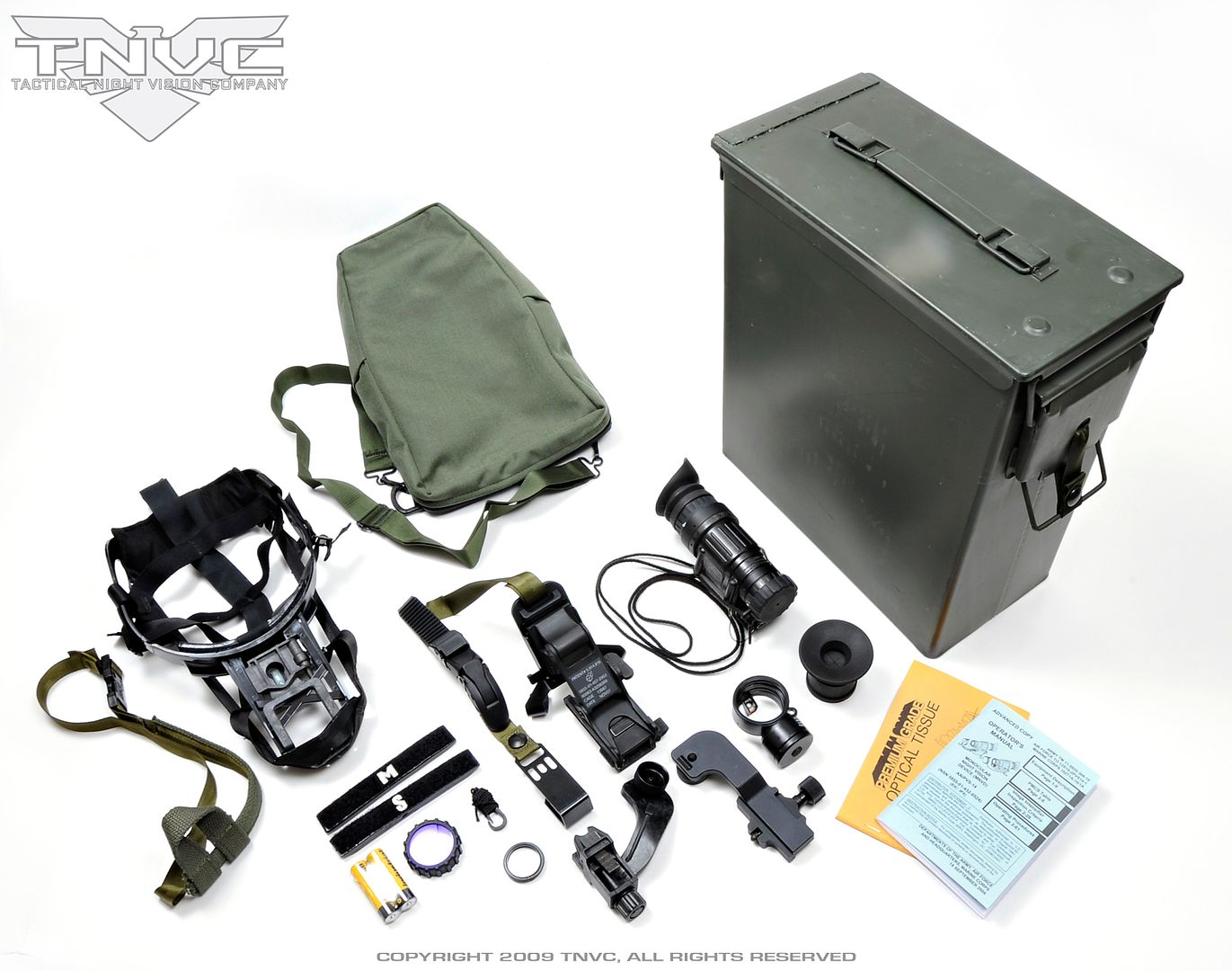
This is the standard-issue AN/PVS-14 for the U.S. Military. These units are generally not available for commercial or law enforcement sales. They are built for the DoD. But, every once in a while the government backs out of a contract or something comes up where ITT is left with a bunch of MILSPEC units. At these times, ITT will sell these over-runs to their distributors. At this time, we do have AN/PVS-14's available for sale to the public. These are the exact "as-issued" kits. They have all the same features as the Night Enforcers. The main difference is that these kits come with more accessories than the Night Enforcers. Now, something I should mention about the tubes: While these units have very nice aesthetics, we do not have the same control over the image quality that we do with the Night Enforcers. Because the Night Enforcers are always available, it is not a big thing for us to send one back if it has blemishes we don't like. But, Uncle Sam is not as picky as we are and one or two blemishes towards the center of the image are acceptable to pass for MILSPEC. Basically, these AN/PVS-14's are what they are and we cannot guarantee there will be no blems towards the center of the image. Like I said, these do look good, though.
MILSPEC AN/PVS-14’s do not come with a factory data sheet for the installed tube. The DoD does not care about the individual specs for the tube, nor do they care to store and catalog data sheets for hundreds of thousands of AN/PVS-14’s alone. Part of the MILSPEC qualification test is that the installed must meet MILSPEC minimum standards. Uncle Sam only cares that it passes this test. If it does not meet these requirements, it would not pass the MILSPEC test and be shipped to the government in the first place.
As for the extra accessories: this is actually a very good deal if you were planning on purchasing these accessories anyway. The accessories included in the AN/PVS-14 kit represent a significant savings from buying them separately. But, you must also analyze what they are. These are the standard issue MILSPEC accessories. The helmet and weapon mount are not the best high-speed kit available and you may choose to use different accessories. If this is the case, are these accessories worth the extra money to you? They are serviceable, but there are better quality, more adjustable, better designed options available. Food for thought.
In comparing the AN/PVS-14 to the Night Enforcer PVS-14, you will find that both units are practically identical. But, for some users, the fact that the AN/PVS-14 model is not always available to the consumer market and it is the official U.S. Government Issue item (complete with label), is a big selling point.
TNV/PVS-14 ITT Exelis Gen3 PINNACLE
TNV/PVS-14 L-3 Infinity OMNI VIII MILSPEC
TNV/PVS-14 Gen3 COMSPEC
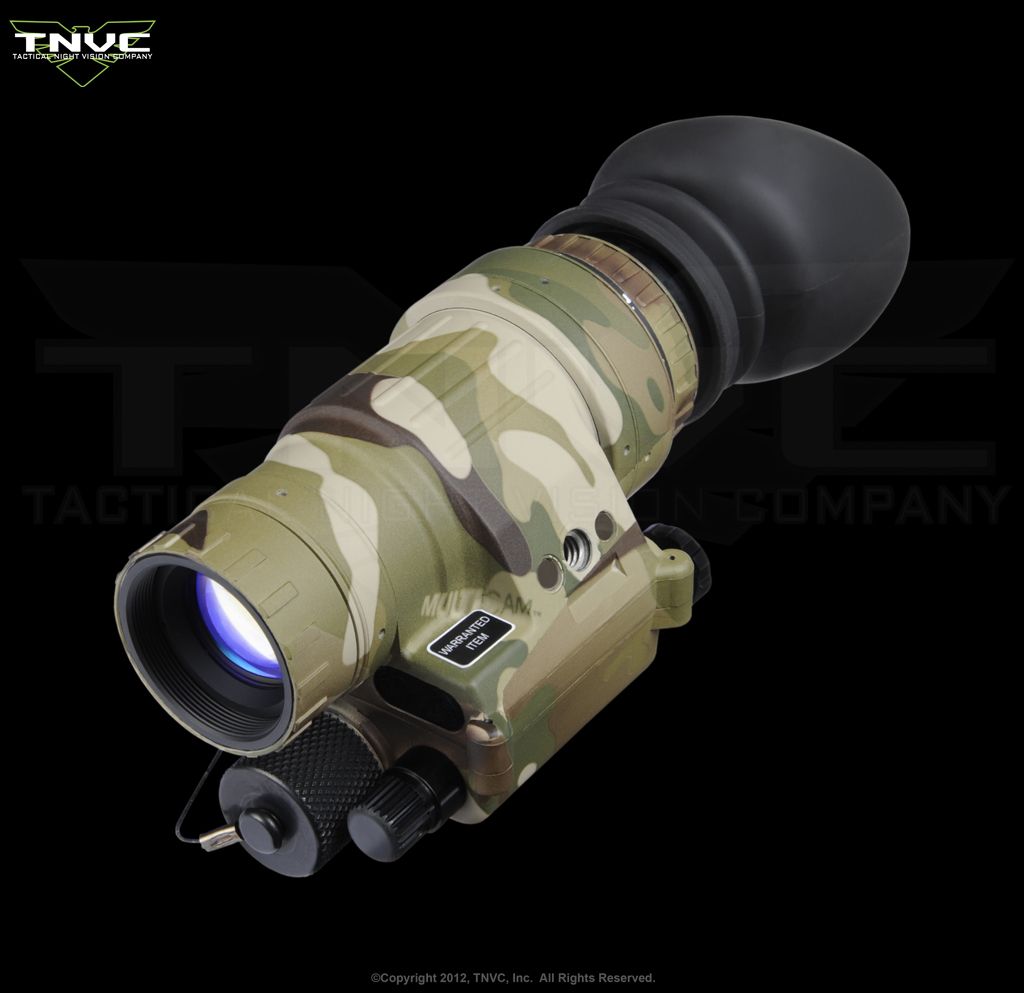
We launched the TNV/PVS-14 line in fall of 2012 and it was an immediate success. We decided to establish our own house brand of the popular PVS-14 goggle so that we could offer customers a better deal on pricing and pick/choose what would be included in the various kits we offer. But, the biggest reason for developing our own private label goggle is our ability to determine the minimum spec for the tube we install. TNV/PVS-14’s are built with a higher minimum spec tube than factory-built systems. They are built using brand new factory parts and tubes. The TNV/PVS-14 line is available in three different tube configurations: ITT Exelis Gen3 PINNACLE©, L-3 Infinity OMNI VIII MILSPEC, and Commercial Spec (COMSPEC). Each model is available in three different housing finishes: Standard uncoated Black, Flat Dark Earth (FDE), and Licensed Crye Precision Multicam. And, each model is available is available in three different kits: Basic, Weapon, and Full. All TNV/PVS-14’s come with a factory data card that tells you the exact specs for the installed tube.
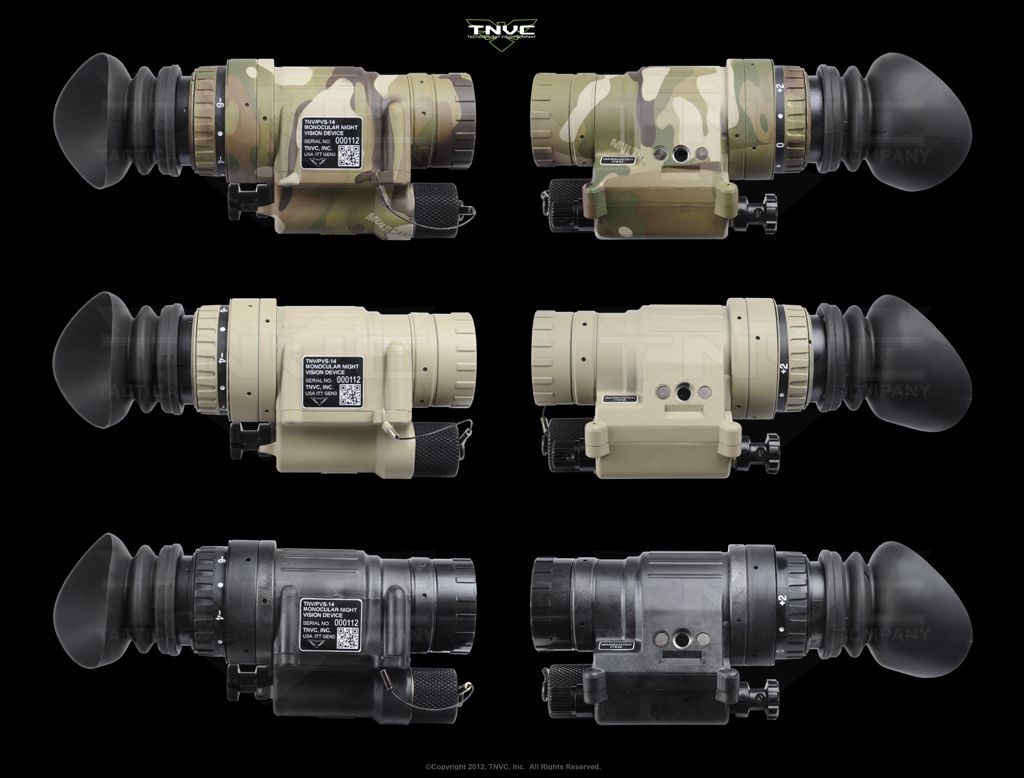
**Off on a Tangent 4**
As discussed earlier, there are a lot of "home brew" systems on the market. Depending on who is assembling them, they can be just as good as factory-built units or they can suck balls. Just about every night vision dealer on the internet offers some sort of "home-brew" system. In fact, the PVS-14 is one of the only monoculars that has a factory-built unit because the manufacturer, ITT Exelis, makes the tubes and the housings. Remember when I said that ITT and L3 are the only two image intensifier tube manufacturers in the U.S., approved to make tubes for the U.S. Government? Well, there are a lot of other night vision manufacturers who make their own housings and optics. These companies will use tubes from ITT or L3 to make their own night vision devices while also selling their housings/optics to dealers who will further build night vision systems.
When perusing the various dealers online, you will come across various PVS-14's with different prefixes (example: TNV/PVS-14, MVPVS-14, NVPVS-14, etc.). These systems are "home-brew" from the dealer whose site you are looking at. The prefixes stand for the dealer's name such as TNV/PVS-14= Tactical Night Vision Company, MVPVS-14 = Morovision PVS-14, and NVPVS-14 = Night Vision Depot PVS-14. So,if you see a PVS-14 with a prefix other than "NQ," "NE," or "AN," you are looking at a home-brew system.
**End Tangent 4**
Data Sheets are like certificates of authenticity and are very important to tube. Unless the system is being built for a government contract, the tube must come with a data sheet. This is going to tell you and any other buyer after the initial purchase exactly what the tube is. Buyers are becoming increasingly educated on night vision, which is a very good thing, and they are beginning to understand what data sheets mean. Now, there is a lot of stuff on a data sheet. Honestly, most of it is going to be of no consequence to most people. The main things to look at that have the most impact on observable performance are lp/mm (Line Pair per Millimeter – Resolution), SNR (sometimes shown as S:R – Signal to Noise Ratio – Lowlight Performance), and HALO (Bright Light Representation). There are other important factors in grading a tube, but these are the most often looked-at factors.
We are often asked which is the best version of the TNV/PVS-14. This is dependent on the customer’s mission. Let’s take a look at the differences.
The ITT Gen3 PINNACLE© (F9815) tube is the same type of tube used in the MILSPEC AN/PVS-14 for standard issue. As discussed above, these tubes have incredible light-gathering capability. But, the use of the thinner thin film causes them to be more sensitive to recoil when mounted on a weapon. Thus, PINNACLE© tubes are only rated for use on 5.56x45mm NATO weapon platforms. Since this is the standard issue cartridge for NATO, the military was cool with it, and it became the standard issue tube for the PVS-14 monocular. Technically, these are commercial grade tubes only because ITT Exelis does not sell MILSPEC tubes on the commercial market. If given the opportunity to undergo the MILSPEC test, they would most likely pass, but MILSPEC testing is an added cost and logistic.
The L-3 Infinity OMNI VIII MILSPEC (MX11769) tube is L-3’s latest tube offering. L-3 does not make a MILSPEC PVS-14, but they do make MILSPEC PVS-14 tube it is a standard configuration tube used in many different night vision devices. Initially, L-3 tubes were a bit behind the power curve compared to ITT’s PINNACLE© offering. They used a thicker film that blocked more incoming light. However, the thicker film did make them able to stand up to slightly higher recoil. But, L-3 was not going to sit idling by while ITT Exelis stole the show. And in the past couple years, L-3 has really closed the gap in tube performance to the point where they are actually neck and neck with ITT in image output performance. But, they achieve it in a different way. L-3 has developed a way to incorporate 20% more holes in their Micro Channel Plates, allowing the electrons to have 20% more surface area to impact and multiply. What does this mean? It means that although L-3 tubes do not gather as much light as ITT tubes, they multiply the gathered light more than ITT. The result ends up being a wash between the two. One thing to note is that they still retain the thicker film which allows them to stand up to a bit more recoil than the ITT PINNACLE© variants. These tubes are rated to include 6.8 SPC and 300 Blackout. These tubes are actual MILSPEC tested to current OMNI VIII Contract standards. That is why they cost a bit more than their ITT counterparts.
The third variant is the
COMSPEC tube. These tubes start life as L-3 image intensifiers, but they sustain some slight edge chips or edge imperfections during the manufacturing process. This damage is enough to keep them from being certified MILSPEC or commercial spec at the factory and would usually mean they would be destroyed since it would cost more time and money to fix the issue than start over with another tube. However, these tubes are purchased by a third party and refinished, ground, polished, and final assembly completed. They perform well, but cannot qualify as government-quality because they are not finished at L-3 or ITT. These COMSPEC tubes are well received and sold at a lower price than factory tubes, making them especially attractive to budget-minded buyers.
So, with the information above, the end decision comes down to the buyer as which TNV/PVS-14 variant best suits them.
NVPVS-14B
The NVPVS-14B is not sold on our website because it is an item we usually do not carry except around the holidays. These are budget PVS-14's that are built with Grade B tubes. Grade B means the tube did not meet spec at the factory because it was blemished. These tubes are then sold at reduced price to dealers who want to make less expensive night vision devices. We pride ourselves in only offering the best gear available, but we also realize that some folks can't necessarily afford it. So, we offer these around the holidays. But, we will always advertise Grade B tubes as Grade B tubes.
**Off on a Tangent 5**
Grade B tubes are something you must watch out for. Unfortunately, there are a lot of snakes out there who are more than willing to take advantage of unknowing buyers. Night Vision is a very small niche in the overall tactical market and a lot of buyers do not do their research before purchasing. It seems crazy to me to not know everything you can about a 3K optic before swiping the Visa, but some people do it anyway. Knowing that there are many folks like this, some night vision sellers will purchase Grade B tubes and falsely advertise them as standard tubes with no defects. Sometimes this is done intentionally to make a buck off an unsuspecting customer. Other times, it is done out of the builder’s own ignorance of the industry. There is no certification needed to sell night vision and like everything else; some dealers have no idea what they are talking about. After the customer gets the product, the seller cuts off all communication and support, leaving the buyer SOL. This is a very unfortunate situation, but one that can be easily avoided. On the same note, if you understand what Grade B means, and are OK with that, then by all means, purchase it.
**End Tangent 5**
Another often-asked question about PVS-14's concerns used equipment. I probably talk to at least 2-3 guys a week who call up asking about PVS-14's. After spending 15-20 minutes discussing the PVS-14 and the different versions, he then says "Well, the reason I'm asking all these questions is because I know a guy who is selling a PVS-14 at a very good price and wanted to know a little background on what I should be looking for." Talk about being taken advantage of. Here is some guy who wastes almost 1/2 an hour of my time only to let me know he never had any intention of buying from me. TNVC is known for having experienced shooters from the military and law enforcement community who understand night vision and its practical applications. We spend a lot of time on the various forums talking to people about NV and are more than happy to spend the time on the phone too. But, I gotta say, there are few things that piss me off more than being taken advantage of. So, I would be remiss if I didn't discuss used night vision.
Buying used night vision is a gamble, pure and simple. It is usually a bad gamble unless you are an expert, and even then, you are buying on faith. My advice is to not buy used night vision. I'm not saying this to scare people off so they give me their business (although I would not turn it down). I am saying this because there are way too many unknowns to plunk down so much money with "some guy" on an optic whose history is impossible for you to know. The people who ask me about buying a used PVS-14 will usually tell me they can buy it "for like $2,000" and its "barely used." OK. Let's stop and analyze this for a second. If you were an upstanding person who didn't lie to others and had a $3,600 optic that was in great condition and had been barely used, why would you sell it for 2K or less? Think about that. I have always gone on the assumption that if something seems too good to be true; it is. While $1,500-$2,000 seems like a great price for a "like new" PVS-14, we are still talking $1,500-$2,000. That's a lot of money. Too much money to risk buying something that may be damaged or nearing the end of its life.
While military-grade night vision devices are relatively robust, they are still going to get messed up taking a header off a table onto the concrete patio or slamming into a rock while mounted on some guy's head who just tripped in the woods. This damage could knock things loose, unseat the tube, break seals, crack the housing, damage the optics, etc, etc. A lot of these damages might not be readily apparent. Also, Gen3 tubes have a finite lifespan. A Gen3 tube will last about 10,000 hours. Do you know how many hours the seller has on the tube? Does he? 10,000 hours is a long time, but if the device saw a lot hunting use or was accidentally left on when it was put away, there might be a lot of hours gone. Also, who built the system and what kind of warranty might be available? Unless it has factory ITT or L3 labels, you are looking at a home-built system that could have been assembled by Billy-Bob in his wood shed. Bottom line: don't buy used night vision. If you want a PVS-14, save your money and buy it from a legitimate and reputable dealer.
This brings us to Ebay night vision. I would say that the previous statements go double here. There is no way for you to even see the device before purchasing from an Ebay dealer. Ebay is not the place to purchase tactical gear, especially something as specialized as night vision. If someone is selling on Ebay, they are using a "free marketplace" and can usually disappear after a sale has been made. It's like buying a PVS-14 from a shady sidewalk vendor.
So, that about wraps things up. I'm pretty sure I've answered all the normal questions we get about PVS-14's and I hope I was able to educate you a bit on the wonderful world of night vision. Thanks for taking the time to read this. I am working on several more articles that will review, compare, and contrast other Night Vision devices and related gear.
Chip Lasky
Director, Operations
TNVC, Inc.
www.TNVC.com





